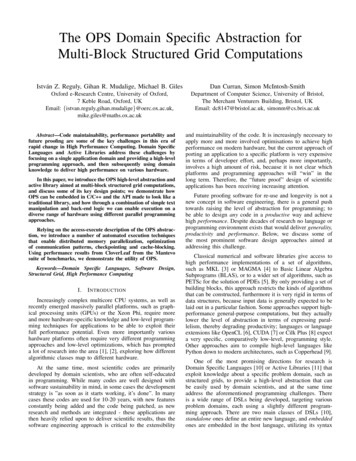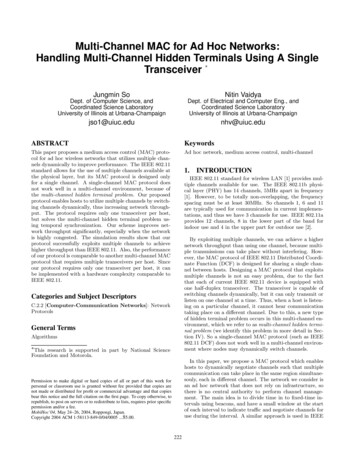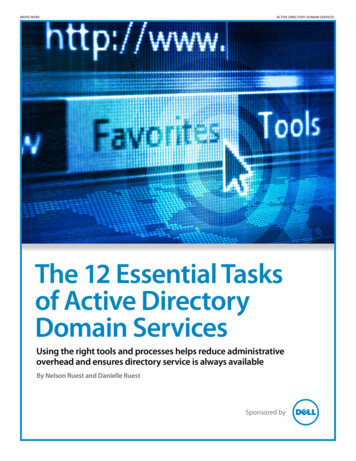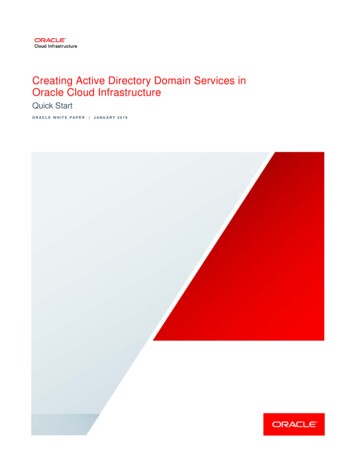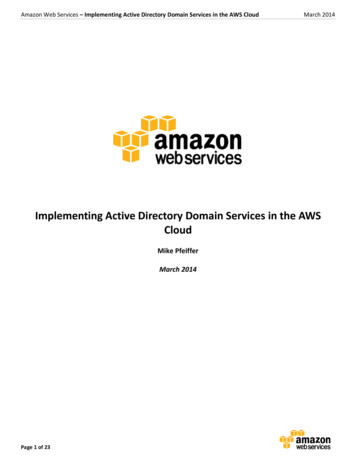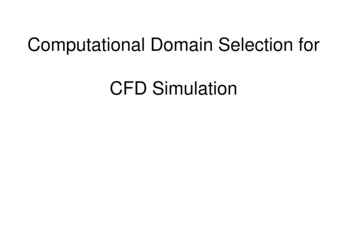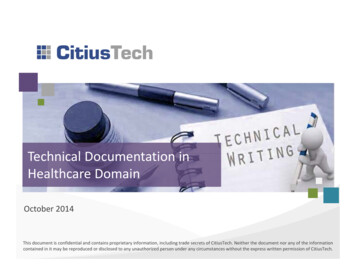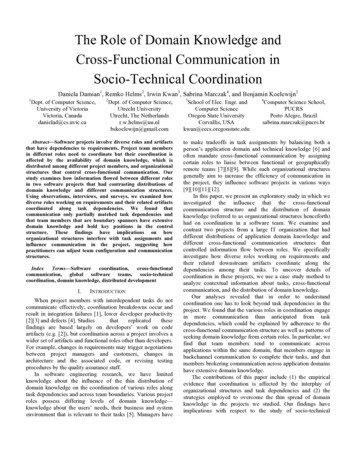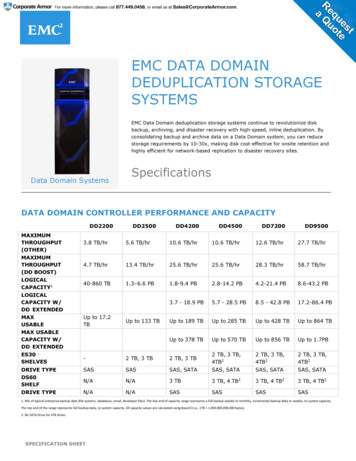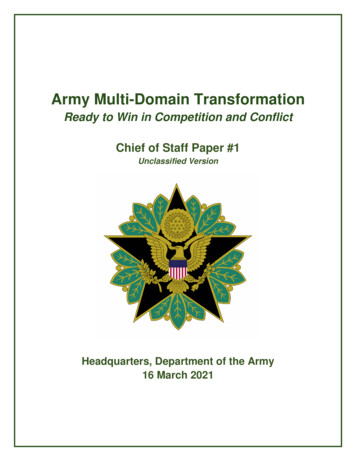
Transcription
Army Multi-Domain TransformationReady to Win in Competition and ConflictChief of Staff Paper #1Unclassified VersionHeadquarters, Department of the Army16 March 2021
UNCLASSIFIEDPrefaceAmerica’s Army serves to protect the Nation and preserve thepeace. Historically, this has always meant preparing for – and whennecessary, fighting and winning – the Nation’s wars. The Army mustalways be ready to fight and win. In this era of great powercompetition, the Army must also compete aggressively to protect our national interests.America has long preserved the peace through its military strength. A large portion ofthis strength comes from the ability to deter war, provided by a strong and capable Army,coupled with strong and capable partners throughout the world.Although our Army still maintains overmatch, it is fleeting. In the face of determinedadversaries and accelerating technological advances, we must transform today to meettomorrow’s challenges. Future conflicts will manifest at longer range, across all domains, and atmuch greater speed, both physical and cognitive. We must therefore continue to implement a 21stcentury talent management system, develop and field new weapon systems, transform ourdoctrine, build new organizations, and change the way we train. This bold transformation willprovide the Joint Force with the range, speed, and convergence of cutting edge technologiesthat will be needed to provide future decision dominance and overmatch required to winthe next fight.The Army provides unique contributions to the Joint Force to help protect our nationalinterests and ensure the security of the American people at home and abroad. In competition, ourNation’s goal remains winning without fighting by leveraging all elements of national power.Deterrence is one critical part of competing successfully. To deter aggression, the Joint Forcemust have an irrefutable, demonstrated ability to fight and win. To advance our interests incompetition more broadly, the Army maintains forward presence and fosters enduring landpower partnerships around the world. The Army also leverages an array of capabilities to operatein the information space and ensure that the nation can consistently win with the truth. Weprovide mobile long range fires, sustainment, protection, and forces able to maneuver within anadversary’s anti-access/area denial (A2/AD) layer. And we boost the credibility of our deterrentmessage with our demonstrated commitment to closely integrate with the rest of the Joint Force.As demonstrated in 2020, the Army’s high readiness levels and breadth of expertiseallowed us to provide timely and effective support during times of crisis. In January, we helpeddemonstrate American strength and resolve overseas to deescalate and prevent conflict. Duringthe COVID-19 pandemic, Army scientists supported national vaccine, therapeutic, and testingefforts; the Army Corps of Engineers aided mayors and governors in developing emergencytreatment facilities; and our Army medical and operational units provided urgently neededsupport across the country. Army units also provided significant professional support tocountless American communities, including responding appropriately to civil unrest, hurricanes,wild fires and floods.The United States Army faces an inflection point that requires innovation, creativity, andentrepreneurship in the application of combat power. Our Nation’s adversaries have gained onthe Joint Force’s qualitative and quantitative advantages. If the Army does not change, it riskslosing deterrence and preservation of the Nation’s most sacred interests. I set an ArmyAimpoint for 2035 as the date at which the Army will be modernized and prepared to dominateour adversaries in sustained Large Scale Combat Operations (LSCO). 2028 is our Waypoint, aiCSA Paper #116 March 2021
UNCLASSIFIEDTable of ContentsPreface . iI.Introduction . 1II.The Emerging Military Problem . 3a.Outflanked in Competition . 3b.Contested Globally . 3c.Fractured and Disintegrated. 4III.MDO During Conflict . 5a.The Future Challenges of Large-Scale Conflict . 5b.Landpower Advantage During Conflict . 6IV.MDO During Crisis Response . 10a.The Future Challenges of Crisis Response . 10b.The Added Value of Army MDO During Crisis . 10MDO During Competition . 15V.a.Expand the Landpower Network . 16b.Demonstrate Range of Capabilities . 17c.Develop New Capabilities . 19VI.Change: Getting to the MDO Aimpoint . 20a.Army Continuum of Analysis (ACA) . 20b.Gaining Positional Advantage . 21c.Gaining Capability Advantage . 22VII.Conclusion . 28Annex A. Glossary . 29iiiCSA Paper #116 March 2021
UNCLASSIFIEDI.IntroductionThe United States is facing an unprecedented set of challenges to our national interests.China and Russia continue to challenge the rules-based international order. Both have becomeincreasingly more assertive in an effort to advance their agendas, aimed at supplanting the U.S.globally. By 2040 China and Russia will have weaponized all instruments of national power toundermine the collective wills of the United States, Allies, and partners, while simultaneouslycultivating their own security partnerships. This will lead to an unstructured internationalenvironment where the line between conflict and peace is blurred. As China and Russia continueto modernize their militaries, the Joint Force will find it increasingly difficult to deter their illicitand aggressive actions.Our adversaries have developed asymmetric approaches to undermine our strengths andexploit our weaknesses. The most striking example of this is their investment in anti-access/areadenial (A2/AD) capabilities designed to prevent the U.S. from projecting military power.Technological advances have enabled the integration of space, cyber, information, and electronicwarfare (EW) capabilities that can halt American power projection before it begins. Artificialintelligence, autonomy, and robotics will continue to change the character of operationalcampaigns, resulting in a battlefield that is faster, more lethal, and distributed. In conflict, ouradversaries will add to stand-off through the employment of modern chemical, biological,radiological, and nuclear (CBRN) weapons. This layered approach erodes Joint freedom ofmaneuver and reduces the effectiveness of other instruments of national power. The urgent needfor transformational change to meet these emerging challenges cannot be overstated. The Armyis poised to deliver this change.The Multi-Domain Army of 2035 introduces a transformational change to jointwarfighting. By 2035, the Army will enable the Joint Force to maneuver and prevail fromcompetition through conflict with a calibrated force posture of multi-domain capabilities thatprovide overmatch through speed and range at the point of need. Dynamic employment andposture of Army forces during competition will provide range in depth to penetrate complexA2/AD systems and achieve cross-domain effects—creating opportunities and providing optionsto deter, deescalate, or promptly transition to win the first battle. Army formations andcapabilities will provide the necessary speed, both physical and cognitive, to achieve decisiondominance required for a faster-paced, distributed, and complex operating environment. TheMulti-Domain Army will set the conditions for the Joint Force to fight and win integratedcampaigns necessary to defeat state actors.Now and in the future, first battles are decisive to the outcome of campaigns. Winningthe first battle or preventing a fait accompli in crisis will be necessary to prevent prolongedconflict and escalation. Ground forces will decisively shape the first battle by leveragingpositional and capability advantage to rapidly deliver options for crisis response, and to win inconflict. Resilient, mobile, integrated, and survivable ground forces will offer the Joint ForceCommander with an array of asymmetric options for deterring and defeating adversaries in alldomains. Dynamically postured forward, in concert with the collective effort of Allies andpartners, ground forces can defeat sophisticated adversary defensive schemes from inside1CSA Paper #116 March 2021
UNCLASSIFIEDpositions, creating corridors for air, maritime and all-domain forces to exploit. In all domains,Army capabilities will sustain, enable, extend, and expand the reach of both defensive andoffensive actions.In competition, the Army provides the Department of Defense (DoD) with foundationalcapabilities and capacity to shape the environment. Army forces pursue relative positional andcapability advantage to support Joint and political objectives. The former is gained primarilythrough expanding the Global Landpower Network, in conjunction with Allies and partners. Thelatter is gained through the development of capabilities, force structure, doctrine and training tosupport multi-domain operations (MDO) at the speed of innovation. Demonstrations of jointassured power projection enhance the credibility of military deterrence, enabling policy makersto employ the right mix of diplomatic, economic, and information levers to prevent a conflictbefore it starts.Army Multi-Domain Transformation describes why and how the U.S. Army musttransform to enhance our core competencies and become a multi-domain force, with the rightcapabilities in the right place to enable the Joint Force to win, from competition through conflict.It further describes the application of the Multi-Domain Operations Concept, first published in2018, across competition, crisis response, and conflict to support Joint All Domain Operations.2CSA Paper #116 March 2021
UNCLASSIFIEDII.The Emerging Military ProblemThe Joint Operating Environment (JOE) asserts that by 2040, the decline of the 20thcentury international order will lead to an unstructured international environment where the linebetween conflict and peace is blurred. America’s adversaries, enabled by the proliferation of newtechnologies, will restrict our freedom of action and erode our strategic advantages. By 2040, ouradversaries will develop novel asymmetric capabilities. Of these, China presents the mostenduring strategic challenge, and is most likely to reach military parity with the Joint Force by2040. If we fail to address these emerging threats, the Joint Force will face significant risk ofbeing outflanked in competition, globally contested, fractured, and disintegrated.a. Outflanked in CompetitionAdversary attempts to outflank the Joint Force in competition will require us to reinforceour relationships with Allies and partners. The United States’ alliances and partnerships are adecisive advantage in competition, but our ability to maintain this advantage is not preordainedin this era’s contest for regional and global leadership. To this end, mutually beneficial alliancesand partnerships are crucial to success. By building upon mutually beneficial relationships, theArmy enables the Joint Force to provide timely response options in every contingency.Our adversaries will likely prefer to avoid direct conflict with the United States, or tolimit conflict in both scope and duration. This intent, paired with emerging capabilities to hamperU.S. intervention, means that our adversaries will deliberately position themselves to achievetheir strategic goals without fighting, or to seize their objectives quickly as a fait accompli,before they breach the U.S. threshold for armed conflict.b. Contested GloballySince Operation Desert Storm, China and Russia have studied the American conduct ofwar, and have designed concepts and capabilities to counter our strengths and exploit ourweaknesses, particularly in force projection. The Joint Force can no longer assume that thehomeland is a sanctuary, or consider the ‘global commons’ uncontested. Joint
doctrine, build new organizations, and change the way we train. This bold transformation will provide the Joint Force with the range, speed, and convergence of cutting edge technologies that will be needed to provide future decision dominance and overmatch required to win the next fight.
